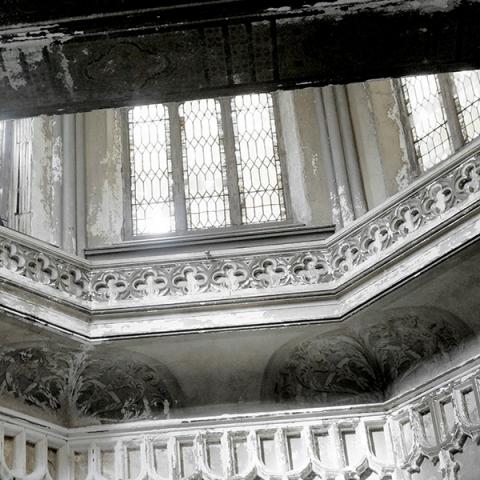sara.codarin_519
Digital Manufacturing e Cultural Heritage_P2
Il presente contributo indaga le possibilità progettuali e realizzative definite dall’utilizzo di strumenti robotici per simulare una procedura di restauro on site attraverso additive manufacturing. A tale scopo si è deciso di ipotizzare un intervento di fabbricazione additiva, programmata attraverso algoritmi generativi, su una lacuna muraria riprodotta in laboratorio a seguito di una campagna di rilievo su un edificio storico in stato di degrado dovuto ad incuria e abbandono.
Digital Manufacturing and Cultural Heritage_P2
The present contribution aims at investigating the role of new digital technologies and manufacturing tools that could support the decision-making phases for innovative interventions on Cultural Heritage. In turn, knowledge of traditional construction systems and craft methods as a metaphorical boundary, in which the design outcome should be tailored, will be required.

Digital Manufacturing e Cultural Heritage_P1
L’attuale avanzamento della ricerca nell’ambito della digitalizzazione dei processi progettuali e costruttivi pone la necessità di analizzare come le più moderne tecniche di acquisizione tridimensionale e produzione materiale possano avere una ripercussione concreta sulle sequenzialità operative che caratterizzano il settore edilizio. Inoltre, l’ipotesi di trasferire le competenze fino ad ora acquisite ad un approccio su manufatti architettonici esistenti si configura come un’opportunità per indagare quali reali benefici sia possibile definire nell’organizzazione di un cantiere digitale di restauro. Il testo che segue rappresenta l’impostazione metodologica di una ricerca dottorale applicata nel campo del digital manufacturing, di cui verranno esposti i risvolti pratici in un secondo contributo.
Digital Manufacturing and Cultural Heritage_P1
The current advancement of the research within the construction sector is the missing piece for bridging the gap between the digitalization of building processes and the new paradigms of production of architectural components (Labonnote et al., 2016). The renewed markets needs and contemporary design languages require in-depth digital proficiency for the management of representation tools (process innovation) and production (product innovation). “Turning digital data into matter” (Gershenfeld, 2012), in the building design field, is the primary challenge to be faced in order to demonstrate a possible transfer of benefits to sectors that are related to the building site, for new constructions or interventions on Cultural Heritage (Medici & Codarin, 2018). On the one hand, nowadays digital tools meet the needs of the actors involved in the design process to communicate through a common language. On the other hand, the scientific community agrees to state the importance of deepening the most updated digital fabrication systems with the aim of elaborating e a methodological approach that prevents the technique to prevail over the cultural assets a project requires (Gerber & Ibañez, 2015).
The present research uses as a case study the restoration site and tries to structure a dialogue between artisans craft and possible IT integrations (Calzolari et al., 2017) to investigate the dichotomy between technical and cultural assets in construction processes.
Moreover, this study systematises the current state-of-the-art on Cultural Heritage conservation methodologies and proposes an innovative workflow for recovery projects on existing architectural envelopes in a state of degradation. Digital survey technologies and additive layer manufacturing tools are an opportunity to bring back together design processes and traditional manufacturing procedures (Stevens & Nelson, 2015) outlining the characteristics of the future digital craftsman: “the automatic feedback between the machine and the material […] is the next step of digital craftsmanship” (Carpo, 2014).
Tecnologie di stampa 3D
La produzione edilizia ad oggi afferisce a tecniche e serialità produttive i cui caratteri di innovazione non sono sempre rispondenti agli aggiornati profili esigenziali della domanda. Il presente contesto culturale ha indirizzato la ricerca scientifica alla sperimentazione di tecnologie di cantiere inedite per la riproduzione di singoli componenti, sezioni strutturali, finanche intere porzioni di edificio. In particolare, i sistemi costruttivi di stampa 3D, già applicati per la costruzione di nuovi involucri edilizi, aprono un dibattito su un possibile utilizzo nell’ambito dei processi di recupero e valorizzazione del patrimonio architettonico esistente.
3D printing technologies
Nowadays the construction industry refers to methodologies and procedural arrangements strongly rooted in building traditions and consolidated technological choices which innovation features do not always respond to the up-to-date demand requirements. The present cultural background has addressed the scientific research towards the experimentation of new automated building-site technologies, belonging to the industrial production field, for the elaboration of individual elements, structural sections or building volumes aimed at defining future constructive scenarios, especially in recurrent constrained or emergency conditions where the use of non-standardised components is required.
These practices currently take into account the experimentation of new materials and the combined use of three-dimensional survey systems, digital modelling software, and specifically programmed implementation machines.
